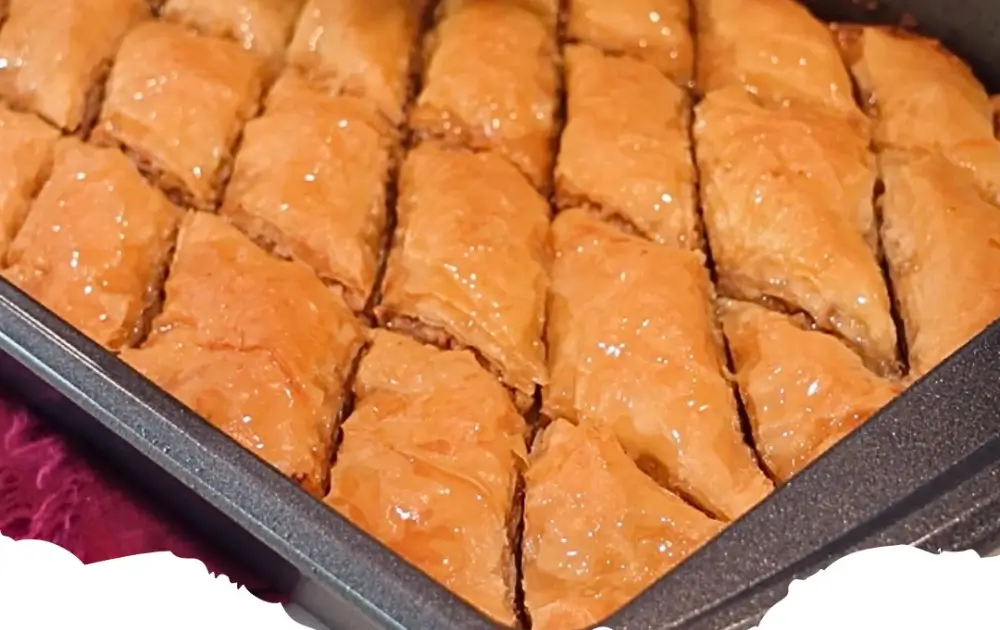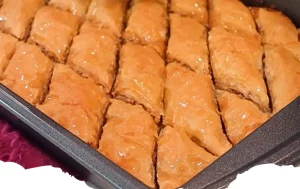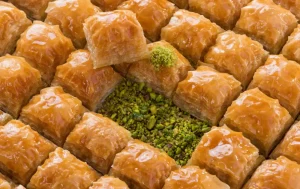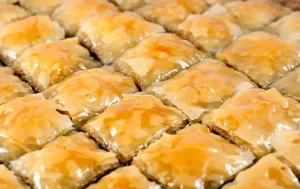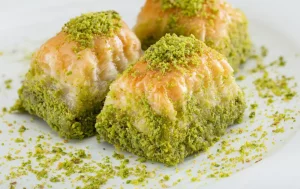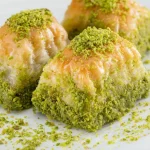Greek Baklava stands as a testament to the rich culinary tradition of Greece, offering a sweet, nutty, and crispy treat that has enchanted taste buds for centuries. This delectable dessert is much more than a simple pastry; it’s a piece of Greek heritage, layered with history and tradition. Crafted with precision and care, baklava combines flaky phyllo dough, a hearty filling of chopped nuts, and a sweet syrup that brings it all together in a harmonious blend of flavors and textures.
Crafting the Perfect Layers
The art of making Greek Baklava begins with the preparation of the phyllo dough, a process that requires skill and patience. The dough must be rolled out into thin sheets, delicate enough to be translucent yet strong enough to hold the layers of filling. Each sheet is carefully brushed with melted butter, then stacked to create a base for the nut mixture. Traditionally, a combination of walnuts, almonds, and pistachios is used, finely chopped and often mixed with cinnamon and clove for an extra burst of flavor.
The Syrup: Sweetness That Binds
After the layers are assembled and the pastry is baked to a golden perfection, the magic of baklava truly comes to life with the addition of syrup. Made from sugar, water, and honey, sometimes enhanced with lemon juice or rose water, the syrup is poured over the hot baklava. This crucial step not only adds sweetness but also ensures that the layers stick together, creating a moist interior and a perfectly sticky texture that baklava is known for.
A Culinary Tradition Passed Down Through Generations
The preparation of baklava is often a family affair, with recipes and techniques handed down through generations. Each family boasts its own variation, perhaps a special ingredient or a unique method of layering, making their baklava distinct. This passing of knowledge from one generation to the next has kept the tradition alive, allowing for the preservation of this beloved dessert’s authenticity and significance in Greek culture.
Serving and Enjoyment
Baklava is not only a dessert; it’s a celebration of culture and tradition. It is typically served during special occasions and holidays, such as Easter and Christmas, symbolizing joy and festivity. Cut into diamond or square shapes, each piece of baklava is a testament to the meticulous craftsmanship that went into its creation. To fully enjoy baklava, it is best paired with a strong coffee or tea, which complements its sweetness and enhances its rich flavors.
The Global Journey of Greek Baklava
From its origins in the Ottoman Empire to its status as a beloved dessert around the world, Greek Baklava has embarked on a remarkable journey. Its popularity transcends borders, making it a favorite in various cultures and cuisines. This global appreciation of baklava speaks volumes about its universal appeal, a sweet reminder of Greece’s enduring culinary legacy.
Introduction to Greek Baklava
Greek Baklava stands as a pinnacle of sweet culinary tradition, embodying the rich history and cultural diversity of Greece. This beloved dessert combines delicate layers of filo pastry with a sweet mixture of chopped nuts and honey, offering an irresistible blend of textures and flavors. Revered not just in Greece but around the world, baklava serves as a bridge between cultures, a testament to the shared love of sweet, rich desserts.
The Origins of Baklava
Tracing the roots of baklava leads us into a labyrinth of history, where the confluence of Middle Eastern and Mediterranean culinary traditions birthed this exquisite dessert. While its exact origin remains a topic of debate among culinary historians, baklava has been a staple in Greek cuisine for centuries. It embodies the essence of hospitality and celebration, often prepared for special occasions and religious festivals.
Ingredients and Preparation
The art of making Greek baklava begins with the selection of high-quality ingredients. The core components include thin layers of filo pastry, a generous amount of chopped nuts—typically walnuts, almonds, or pistachios—and a rich syrup made from honey and sugar. The process involves layering the filo pastry with melted butter, interspersing it with the nut mixture, and baking it to golden perfection. The final touch, a lavish soaking in honey-infused syrup, ensures every bite is moist and flavorful.
Cultural Significance
Baklava holds a special place in Greek social and cultural traditions. It is more than just a dessert; it is a symbol of hospitality and generosity. Serving baklava to guests signifies respect and a warm welcome in Greek homes. During festive seasons and religious celebrations, baklava becomes a centerpiece, reflecting the spirit of communal joy and sharing.
Variations Across Regions
While the essence of baklava remains consistent, regional variations across Greece and beyond add a fascinating diversity to this dessert. Some versions incorporate spices such as cinnamon and clove, while others might include a touch of lemon or orange zest in the syrup to add a refreshing citrus note. Each variation stands as a testament to the adaptability and creativity inherent in Greek cuisine, allowing baklava to continually evolve while maintaining its traditional roots.
The Art of Serving Baklava
Serving baklava is an art in itself, often presented with great care to enhance its visual appeal and taste. A typical serving includes a few pieces of baklava, often accompanied by a cup of strong coffee or tea, balancing the sweetness of the dessert with the bitterness of the beverage. In some settings, baklava is also paired with ice cream or fresh cream, offering a delightful contrast in textures and temperatures.

